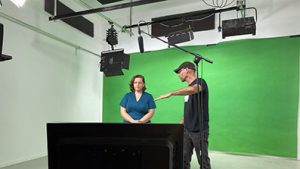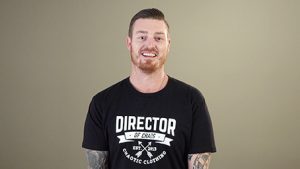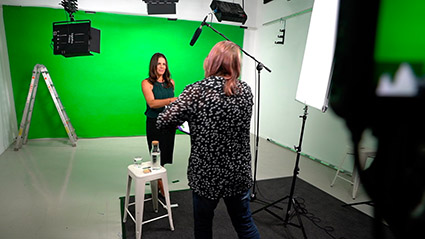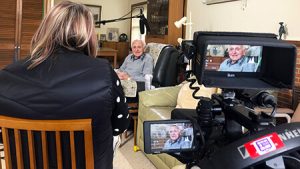Visiting the dentist beats standing in front of a camera, right?.
I should know. A couple of decades ago (cough cough) I started my career as an early morning TV news presenter.
Whilst there weren’t many viewers watching those pre-dawn bulletins in the southwest corner of Britain back in the late nineties – and so the stakes weren’t too high for the network – I liken my experience to being thrown to the lions; albeit with on-trend Harry Potter specs and impressively prominent shoulder pads.
I had no training or guidance on how to prepare to be on camera, and in spite of a well-written script and autocue, I dare say I was fairly atrocious.
Instead I opted for a behind-the-camera career, making TV shows and online content. And along the way I became quite adept at directing on-screen talent to do what I had failed to master a few decades before, being prepared and engaging with their audience.

Check out this awesome video from our writing pal Angela Denly about nervous wees before her filming session.
Today technology and the internet means anyone can film themselves and publish it for the world to see. And for your business, the value of this can be well worth the nerves and hesitation you might be feeling.
Introducing your business, explaining your services, demonstrating products, sharing your knowledge in how-to videos and thought leadership discussion – there are many ways you might find yourself on camera.
And thanks to my old-school experience and new-school tricks, here are my recommendations on how to put your best self forward when it comes to starring in your own business videos.
What to say
Most of us have plenty to talk about and many of us enjoy talking to a captive audience. But video for business, isn’t really about you: it’s about choosing a topic that genuinely will interest your viewers and give them some value in return for giving up their precious time to watch what you have to say.
Be informative, be entertaining and also be concise. That’s the beauty of video – you can say a lot in a short amount of time, communicate concisely and people will retain it.
So be prescient of this when it comes to putting yourself into the hot seat. Unlike blogging and influencers and all that jazz, business video is not a vanity project. It should have purpose and value.
Prepare
As you get more experienced you’ll find talking to camera becomes easier. You’ll start to feel more relaxed, you may get feedback as to what works. You might even get fan mail, as I did – twice – when I was reading the morning news.
But to begin with, it’ll be easier all round if you prepare.
Avoid writing a full length script and learning your lines off by heart; it’s likely to look scripted and less natural.
The whole point of putting yourself front of camera is to be authentic.
Instead jot down a list of bullet points and run through what you want to say before hand. Not only will you feel much more confident, but your delivery too will be far more relaxed.
And of course there’s no harm in practicing. Rehearse what you want to say (maybe even with notes) a few times before you even press record. Only when you feel confident hit record.
Camera
Whether you’re filming yourself on a smart phone or you’ve got a team of pros (or your partner, let’s be honest) doing the heavy lifting, make sure your camera is able to capture a clear and sharp image of you doing your stuff!
If the pros are doing it, you’ll just have to trust them. But if you’re filming yourself – or velfy-ing (video selfie-ing) use a selfie stick, a gimbal or a tripod to hold that camera steady.
Pay attention to your framing. Nobody wants to see the pimples on your nose but being too far away won’t make for a great connection with your audience. Just like the story of the three bears, you’ll need to find that sweet spot that is just right.
Download our free Smartphone Video Cheatsheet
Sound
What? You can’t hear me? Is that better?
Good sound is key if you’ve got something worth saying. Invest in a microphone that plugs into your phone with a cable or an audio jack. You can position it better by using a stand but you’ll need to work out the optimum distance you can stand from your mic to be clearly heard. If you’re a bit more technically minded or likely to be moving, consider a radio mic which allows sound to be wirelessly recorded.
Choose a quiet location; distracting or intermittent loud sounds can dominate your video and make your message less audible. Avoid dominant noise such as music, phones ringing, doors opening and closing, traffic noise, construction and crowds.
And if you’ve got no choice, put the source of the noise behind the microphone where it won’t be so distracting.
If possible do a quick test recording before you commit to a long piece of presenting to camera and always always double check once you have finished recording. Even the pros have been known to not press record when it matters.
Lighting
Smart phones are generally pretty good in lower light conditions, but if you want to make yourself seen – or you’re demonstrating a product for instance – give some thought to lighting.
You want to make filming as easy as possible, so look for natural light sources such as the sun if you’re outside, windows if you’re in or white walls and light spaces. Put yourself in a position where the natural source of light is in front of you, to light up your face and reduce any shadows.
As you create more videos or want a more professional look, you can buy a small led light or other forms of portable lighting.
And as with your sound recording, do an idiot check before you record by taking a quick snap of yourself to heck you’re happy with the lighting.

Background
Pay some thought to your setting when recording videos. The content of your video is more likely to dictate the aesthetic of your video.
If you’re doing a Facebook live at a conference for instance, chose a background that reflects this environment. If you’re creating a series of How to Videos for instance, you might prefer to have a consistent look and style and film that at a desk or in a conference room.
Also remember if you’re in an environment such as an office or studio that you control, you can always dress the area to look pleasing, de-clutter or at least get rid of your mouldy coffee cups.
As with all aspects of your set up, take a quick pic of your framing and double check there’s not a pot plant behind you that will end up “growing” out of your head on a video.

Eye Contact
To connect with your audience, you’re going to have to try and maintain that direct eye contact throughout your video.
That means finding the camera lens and looking into it. Not flicking your eyes from side to side, looking down or above the camera, but right there into the lens.
You want the audience – whether it is one person or many – to see your reaching out to them.
Keep it real
And finally a mention of the type of video content that all businesses yearn to create – authentic video; video that is real, that is true to who you are, your beliefs and what you stand for.
Recording yourself on camera for business purposes is about the most authentic thing you can do. There’s few bells and whistles and clearly it shows the real you (even with make up).
If your delivery, your smile, your content is real, then you’ve delivered a video that is authentic. It’s what your audience want, the humans in your business and your video will do just that.
Chuck in all the technical and logistical tips and you’ll have made, if not an award-winning video, but certainly one that will connect with your customers and hopefully deliver your goals.
Just do it
The very hardest part of the entire process will be making and publishing your very first video.
Trust me, get it over and done with, put yourself out there and connect with people. Video’s the best way to engage with your customers and circle of influence. They’re more likely to warm to you and be more open to your business. We all know better business comes with better relationships. And video is all about relationships.
All you need to do now is hit record…
Stop making excuses and just do it.
And if all feels too much to do solo, we can help with some on-camera training or send the camera dude along to record you professionally.


